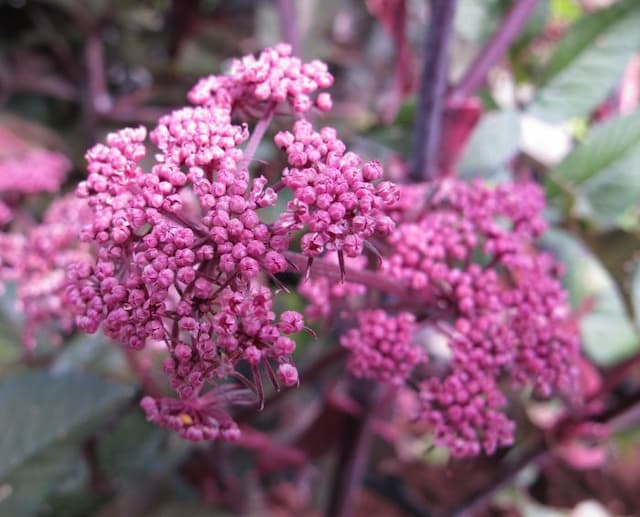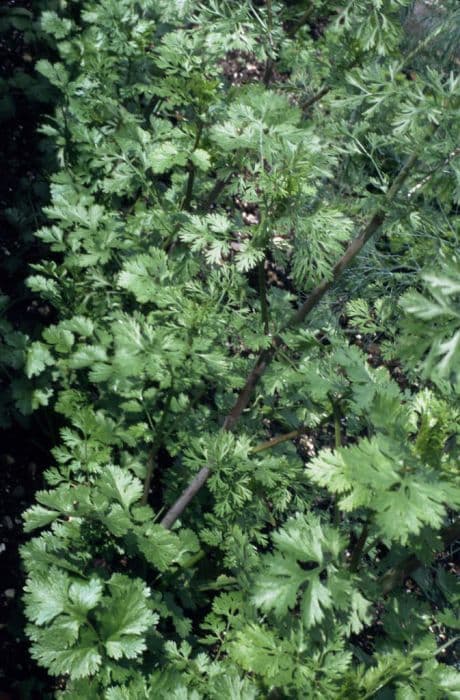Dill Anethum graveolens

ABOUT
The plant commonly known as dill has slender stems that are topped with delicate, feathery green leaves, which are finely divided and soft to the touch. The leaves are arranged in an open manner, conferring a light and airy appearance to the foliage. Dill produces small, vibrant yellow flowers which form umbrella-shaped clusters called umbels, that can be quite attractive. These umbels later give way to small, flat, oval-shaped seeds that are brownish in color, and these seeds are often used as a spice. The entire plant has a distinctive aromatic scent that is commonly associated with pickling.
About this plant
 Names
NamesFamily
Apiaceae.
Synonyms
Dill, Garden Dill, Dill Weed.
Common names
Anethum sowa, Peucedanum graveolens, Peucedanum sowa.
 Toxicity
ToxicityTo humans
Dill, which is the most common common name of Anethum graveolens, is not toxic to humans when consumed in typical culinary amounts. However, in very large doses or in people with specific allergies or sensitivities, consuming dill can potentially lead to undesirable reactions. Some possible consequences may include mild gastrointestinal distress such as diarrhea, nausea, or oral irritation. Skin contact with the plant may cause allergic reactions in some individuals. It is also important to note that dill oil can be toxic if ingested in significant amounts, and excessive consumption may lead to central nervous system issues or photodermatitis, which is a skin reaction to sunlight exposure. However, such instances are extremely rare, and dill is generally considered safe for human consumption.
To pets
Dill is considered to be non-toxic to pets such as dogs and cats. This plant, recognized commonly as dill, does not typically pose a risk when ingested by pets in small amounts typically found in the environment. However, as with all foods that are not part of a pet's regular diet, dill can potentially cause mild gastrointestinal upset if eaten in large quantities. Symptoms may include vomiting or diarrhea when consumed in excessive amounts. It is always recommended to introduce any new foods to pets cautiously and to consult with a veterinarian if there are concerns about possible sensitivity or if an animal has ingested a large amount of the plant.
 Characteristics
CharacteristicsLife cycle
Annuals
Foliage type
Deciduous
Color of leaves
Green
Flower color
Yellow
Height
2 feet (60 cm)
Spread
1 foot (30 cm)
Plant type
Herb
Hardiness zones
2
Native area
Mediterranean
Benefits
 General Benefits
General Benefits- Culinary Uses: Anethum graveolens, commonly known as dill, is widely used as an herb or spice to flavor meals, particularly in European and Asian cuisines.
- Aromatic: The plant has a distinctive aroma that makes it desirable for use in perfumery, soaps, and essential oils.
- Gardening: Dill is an attractive plant that can add aesthetic value to a garden with its fine, feathery leaves and yellow flowers.
- Companion Planting: Dill can be beneficial in a garden as it attracts beneficial insects such as wasps and other predatory insects that control pests that attack vegetable crops.
- Soil Improvement: When used as a cover crop, dill can help improve soil structure and fertility by adding organic matter as it decomposes.
- Cultural Importance: It has cultural significance in many societies and is often used in traditional ceremonies and celebrations.
- Cooking: Dill seeds are used as a spice, and the fresh dill weed adds a unique flavor to salads, sauces, and soups.
- Food Preservation: Dill is a key ingredient in pickling, where it contributes to the flavor and preservation of pickled vegetables.
 Medical Properties
Medical Properties- Digestive aid: Can be used to help relieve gastrointestinal issues, such as indigestion or flatulence.
- Anti-inflammatory: Contains compounds that may reduce inflammation in the body.
- Antibacterial: Exhibits antibacterial properties, potentially helping to fight off certain infections.
- Carminative: Helps to relieve gas and bloating in the digestive tract.
- Galactagogue: Traditionally used to help increase milk production in nursing mothers.
- Antispasmodic: Can help relieve cramps and spasms in the muscles.
- Diuretic: May increase urine production and help in the removal of excess fluids and toxins from the body.
 Air-purifying Qualities
Air-purifying QualitiesThis plant is not specifically known for air purifying qualities.
 Other Uses
Other Uses- Dyeing Agent: Dill's plants can produce a yellow or light brown dye that can be used to color wool and other fabrics.
- Preservation: When added to pickling mixtures, dill acts as a natural preservative, helping to keep pickles and other preserved foods fresh and flavorful over time.
- Aromatherapy: The essential oil of dill is sometimes used in aromatherapy products for its calming and soothing scent.
- Flavor Enhancer: Dill seeds are used to flavor homemade wines, vinegars, and certain spirits, adding a unique aromatic quality to the beverages.
- Companion Planting: Dill is planted alongside cabbage or onions in gardens to repel certain pests, promoting healthier growth of these vegetables.
- Fish Tanks: Some aquarists use dill as an aquatic plant for fish tanks to enhance the natural habitat and provide a beneficial environment for fish.
- Cooking Utensil: In some traditional cooking practices, dill stalks are fashioned into utensils like spatulas or brushes to apply sauces or glazes.
- Crafting: Dill's feathery fronds are used in floral arrangements, wreaths, and as decorative elements in various handcrafted items.
- Biodegradable Mulch: Dried dill plants can be spread over garden beds as a biodegradable mulch, which can help retain soil moisture and limit weed growth.
- Seed Saving: Hobbyists collect dill seeds not only for replanting but also for trading with other seed savers to diversify their garden without purchasing new seeds.
Interesting Facts
 Feng Shui
Feng ShuiDill is not used in Feng Shui practice.
 Zodiac Sign Compitability
Zodiac Sign CompitabilityDill is not used in astrology practice.
 Plant Symbolism
Plant Symbolism- Protection: Anethum graveolens, commonly known as dill, is often associated with protection. In ancient times, people hung dill over doorways or placed it on babies' cradles to ward off witches and evil spirits.
- Wealth: In some traditions, dill is believed to bring prosperity and wealth. It was believed that carrying a bag of dill seeds could attract financial resources.
- Love: Dill has been used in love spells and was thought to be an aphrodisiac. Its fragrance was said to cure heartache and bring love.
- Good Luck: Carrying a sprig of dill or seeds was considered to be a way of attracting good luck and good fortune.
- Health: Known for its medicinal properties, dill symbolizes health and healing. It has been used in traditional medicine to aid with digestion and relieve stomach ailments.
 Water
WaterDill, the common name for Anethum graveolens, requires consistent moisture for best growth. Water dill plants deeply, about once or twice a week, providing enough water to soak the soil to a depth of 2-3 inches. During dry spells or in particularly hot weather, you may need to water more frequently to maintain moist soil. Avoid overhead watering that can lead to mildew; instead, use a soaker hose or water at the base of the plant. On average, dill might need about 1 gallon of water per week, adjusted for rainfall and temperature conditions.
 Light
LightDill thrives in a location with full sun, which means it should get at least 6-8 hours of direct sunlight each day. An ideal spot would be an unobstructed south-facing garden bed. If growing dill indoors, place it in a sunny windowsill that receives ample light for most of the day. Avoid placing dill in areas with partial shade as it might not grow as vigorously.
 Temperature
TemperatureDill prefers a warm climate and does best in temperatures between 60 and 75 degrees Fahrenheit. It can survive temperature fluctuations with a minimum temperature around 25 degrees Fahrenheit and a maximum temperature not exceeding 90 degrees Fahrenheit. Ideal growth occurs within this temperature range, but dill is somewhat tolerant of cold and heat, though extreme temperatures may hinder its development.
 Pruning
PruningPruning dill is generally done to control its size, remove spent flowers (bolting), and encourage bushier growth. Pinch off the top of the plant to promote branching, and trim away any dead or yellowing leaves for health and aesthetic purposes. The best time for pruning dill is in the late spring to early summer, just before the plants set flowers.
 Cleaning
CleaningAs needed
 Soil
SoilDill requires well-draining, loose, slightly acidic to neutral soil with a pH between 5.8 and 7.0. A 2:1 ratio of potting mix to sand can be ideal, providing adequate drainage while retaining enough moisture.
 Repotting
RepottingDill generally doesn't require frequent repotting as it is often grown as an annual. Repotting every year or when significantly root-bound can be beneficial.
 Humidity & Misting
Humidity & MistingDill prefers mild to moderate humidity levels, but as an adaptable plant, it can tolerate a range of conditions, provided there is good air circulation around the foliage.
 Suitable locations
Suitable locationsIndoor
Place dill in a sunny window sill and water when the topsoil is dry.
Outdoor
Plant dill in full sun, with well-draining soil, after the last frost.
Hardiness zone
2-11 USDA
 Life cycle
Life cycleDill (Anethum graveolens) begins its life cycle as a seed that requires well-drained soil and full sunlight to germinate, typically within 7-14 days after sowing. After sprouting, the seedling grows rapidly, developing a deep taproot and feathery foliage. As it matures, dill produces umbels with yellow flowers in late spring to early summer, typically around 60-90 days after planting. Following pollination, these flowers develop into flat, oval seeds by late summer. The plant completes its life cycle as an annual, dying after seed production. However, dill can self-seed, allowing new plants to grow the following year from fallen seeds.
 Propogation
PropogationPropogation time
Spring-Early Summer
Dill, scientifically known as Anethum graveolens, is typically propagated through seeds. The best time to sow dill seeds is in the spring after the danger of frost has passed. To propagate dill using the most popular method, seeds should be directly sown into a sunny location in well-drained soil. Plant the seeds 1/4 inch (about 6 millimeters) deep and space them approximately 18 inches (around 45 centimeters) apart to allow for their bushy growth habit. Seedlings usually emerge in 10 to 14 days. As dill does not transplant well due to its taproot, starting dill directly in the garden or final container is recommended over starting indoors and transplanting later.








